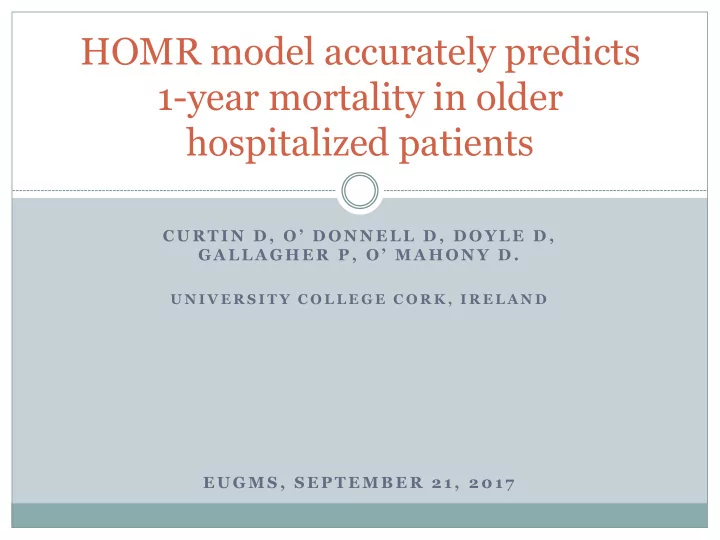

HOMR model accurately predicts 1-year mortality in older hospitalized patients C U R T I N D , O ’ D O N N E L L D , D O Y L E D , G A L L A G H E R P , O ’ M A H O N Y D . U N I V E R S I T Y C O L L E G E C O R K , I R E L A N D E U G M S , S E P T E M B E R 2 1 , 2 0 1 7
Background
George
Estimating prognosis doctors are inaccurate and overly optimistic 1. Parkes CM. Accuracy of predictions of survival in later stages of cancer. BMJ 1972;ii: 29-31. [PMC free article][PubMed] 2. Christakis N, Lamont E. Extent and determinants of error in doctors' prognoses. BMJ 2000;320: 469-73. [PMC free article][PubMed] 3. Vigano A, Dorgan M, Buckingham J, Bruera E, Suarez-Alzamor ME. Survival prediction in terminal cancer patients: a systematic review of the medical literature. Palliat Med 2000;14: 363-74. [PubMed] 4. Christakis NA, Lamont ER. Extent and determinants of error in physicians' prognoses in terminally ill patients. West J Med. 2000 May; 172(5): 310 – 313.
Prediction Models
Prediction Models
Assessing Performance of Prediction models Discrimination (C Statistic) Calibration Transportability
Assessing Performance of Prediction models Discrimination (C Statistic) Calibration Transportability
Discrimination (C Statistic) C statistic ≥0.9 Excellent 0.8 -0.89 Very good 0.7-0.79 Good 0.6-0.69 Fair 0.5-0.59 Poor
Discrimination (C Statistic) C statistic ≥0.9 Excellent 0.8 -0.89 Very good 0.7-0.79 Good 0.6-0.69 Fair 0.5-0.59 Poor
Discrimination (C Statistic) C statistic ≥0.9 Excellent 0.8 -0.89 Very good > 0.7-0.79 Good 0.6-0.69 Fair 0.5-0.59 Poor
Assessing Performance of Prognostic models Discrimination (C Statistic) Calibration Transportability
Calibration Agreement between observed and predicted outcomes <10% difference indicates good calibration
Assessing Performance of Prognostic models Discrimination (C Statistic) Calibration Transportability
Transportability Different population Different location Different investigators
Systematic Review of Prognostic Models “testing of transportability was limited” “insufficient evidence at this time to recommend the widespread use..” JAMA, 2012
The Hospital-patient One-year Mortality Risk (HOMR) Model (2014)
HOMR model Predicts 1 year mortality after hospitalization Cohort >3 million; Adults of all ages C statistic 0.9 <1% difference between observed and expected mortality
HOMR model
HOMR model HOMR Predicted score risk 47 70% 46 63% 45 58% 44 53% 43 50% 42 46% 41 43% 40 37% 39 32%
Assessment of the performance of the HOMR model in an older Irish cohort
Methods Adult inpatients ≥65 under care of geriatric medicine service January 2013 – March 2015 Primary outcome: death within 1 year after discharge from hospital
Results Characteristic 1409 Baseline patients Male 43% ........................................................................... Mean age 82 Emergency admission 94% 1 year 259 1150 Independent 67% Dead alive (18.4%) Home care 21.3% Nursing home 7.7%
Results C statistic 0.79 (95% CI 0.75 -0.82)
Results Calibration: Deaths: 259 (18.4%)
Results Calibration: Deaths: 259 (18.4%) Predicted deaths 403 (28.8%)
Results Calibration: Deaths: 259 (18.4%) Predicted deaths 403 (28.8%) Odds ratio for death: Irish population = North American population
Calibration 100 90 % 80 dead 70 at one 60 year Predicted 50 Observed 40 30 20 10 0 25 27 29 31 33 35 37 39 41 43 45 47 49 51 HOMR score
Calibration 100 90 High % 80 risk dead 70 Medium at one risk 60 year Low Predicted 50 risk Observed 40 30 20 10 0 25 27 29 31 33 35 37 39 41 43 45 47 49 51 HOMR score
Re-calibration 100 90 80 % dead 70 at one 60 year Predicted 50 Observed 40 30 20 10 0 25 27 29 31 33 35 37 39 41 43 45 47 49 51 HOMR score
Discussion
Discussion C-Statistic: Model Description Validation Independent validation Derivation HELP, 2000 Patients ≥80 years, C= 0.73 C=0.74 - emergency admissions (N=1266) (N=150) Walter et al, 2001 Patients ≥70 years, C=0.75 C=0.79 C=0.72 discharged from general (N=1495) (N=1427) (N=122; patients ≥75; 5 medicine service year mortality prediction ) BISEP, 2003 Patients ≥70 years, C=0.83 C=0.77 C=0.73 admitted under general (N=525) (N=1246) (N=122; patients ≥75; 5 medicine service year mortality prediction ) Levine et al, 2007 Patients ≥65 years C=0.67 C=0.65 (N=3643) - discharged from general (N=2739) medicine service MPI, Patients ≥65 years C=0.75 C=0.75 - 2008 admitted to geriatric unit Silver Code, 2010 Patients ≥75 admitted C=0.66 C=0.64 - through the emergency (N=5457) (N=5456) department HOMR, 2014 Adult patients admitted C=0.92 C=0.89 -0.92 C=0.79 under non-psychiatric (N=319 531) (N= 2 862 996) (N=1409; patients ≥65 hospital services years discharged from geriatric service)
Discussion C-Statistic: Model Description Validation Independent validation Derivation HELP, 2000 Patients ≥80 years, C= 0.73 C=0.74 - emergency admissions (N=1266) (N=150) Walter et al, 2001 Patients ≥70 years, C=0.75 C=0.79 C=0.72 discharged from general (N=1495) (N=1427) (N=122; patients ≥75; 5 medicine service year mortality prediction ) BISEP, 2003 Patients ≥70 years, C=0.83 C=0.77 C=0.73 admitted under general (N=525) (N=1246) (N=122; patients ≥75; 5 medicine service year mortality prediction ) Levine et al, 2007 Patients ≥65 years C=0.67 C=0.65 (N=3643) - discharged from general (N=2739) medicine service MPI, Patients ≥65 years C=0.75 C=0.75 - 2008 admitted to geriatric unit Silver Code, 2010 Patients ≥75 admitted C=0.66 C=0.64 - through the emergency (N=5457) (N=5456) department HOMR, 2014 Adult patients admitted C=0.92 C=0.89 -0.92 C=0.79 under non-psychiatric (N=319 531) (N= 2 862 996) (N=1409; patients ≥65 hospital services years discharged from geriatric service)
Discussion Model C statistic HOMR 0.79 CHA2DS2-VASc 0.68 HAS-BLED 0.69
Discussion Can the model be used to predict 1-year mortality in older hospitalized patients?
Conclusion
Conclusion Prognostic models are important HOMR model is robust Compares favourably to other prognostic models Re-calibrated model needs to be tested
Thank you
Recommend
More recommend